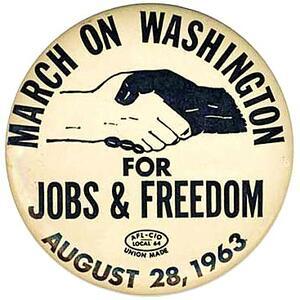MLK through a new lens
Martin Luther King, Jr. Day provides the Jewish community with a unique and multifaceted opportunity each year: it's a chance to turn our communal attention from its inward focus to a more outward-directed perspective. A chance to connect with our African-American neighbors. A chance to celebrate the man who still looms large as a model of religiously-inspired leadership. A chance to recall with pride a time when many Jews stood up for the rights of all people, black or white.
This year, thanks to a new trove of fresh material on Jews and the Civil Rights Movement now available through JWA's Living the Legacy project, we also have the opportunity to go beyond the usual, tried-and-true programming and to bring new perspectives and new questions to Jewish MLK Day commemorations.
Reading Rabbi James Wax's sermon, delivered in Memphis, Tennessee on April 5, 1968 -- one day after King was assassinated there -- gives us a glimpse into the shock and horror of that moment for Jews in the South. Two excerpts from the Freedom Seder held in Washington, DC one year later to commemorate the first anniversary of his death with an interfaith Passover celebration, can open a conversation on the many directions of King's legacy.
A 1963 correspondence between the Hebrew Union Congregation of Greenville, Mississippi to the Reform movement's Union of American Hebrew Congregations (UAHC) reminds us of the diversity of Jewish experience regarding the Civil Rights Movement and MLK. In these letters, the Mississippi congregation expresses its discomfort with the UAHC's decision to invite King to address the Reform movement's Biennial Convention, calling this invitation "ill-timed and ill-advised, and clearly fraught with anxieties for our membership." In his response, the UAHC president, Rabbi Maurice Eisendrath, asserts a moral imperative: "We have done too little... We have heeded too much the complaints of those who disagree with our position on integration, and, if the truth be told, we are... far behind what our ideals demand."
Photos from the March on Washington illustrate the wide variety of Jewish representation in the Civil Rights Movement, allowing several different demographics -- teens, senior citizens, communal leaders -- to imagine themselves at that watershed event, hearing first-hand the gripping words of King's "I Have a Dream..." speech. These photos also encourage reflection on our own social justice commitments and can help us frame questions about what banners we march under.
In addition to containing more than 85 rich primary source documents like these and 15 traditional Jewish texts, Living the Legacy is a full curriculum with 16 ready-to-use lesson plans designed to be used by educators working with 8th-12th graders in both formal and informal educational settings. The flexible lessons can stand alone or be taught in various combinations, such as the trio of lessons suggested for MLK programming in the month of January. All are available for free on JWA's website.
Martin Luther King, Jr. Day, and the Living the Legacy resources, offer us an opportunity both to reflect on the past and engage with social justice issues in the present through the lens of the Civil Rights Movement. Learning more about this searing period in American history and what it has meant to Jews, then and now, will deepen our participation in the ongoing work of making this country a more just place.








Check out the book "Going South: Jewish Women in the Civil Rights Movement" for more info.